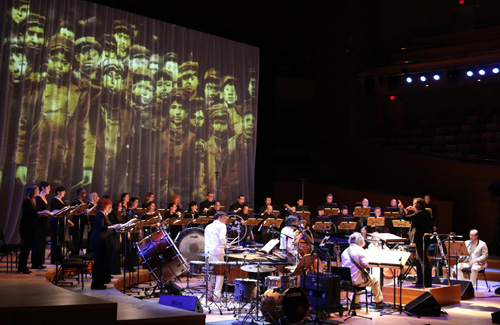
LOS ANGELES – The working class has gained a new champion in the concert hall with the rise of composer Julia Wolfe, who won the 2015 Pulitzer Prize for music for her hour-long oratorio Anthracite Fields, based on the history and lives of the Northeast Pennsylvania coal miners.
Based on her past work, and the themes of upcoming commissions, it seems that concertgoers and music organizations as prestigious as the New York Philharmonic are ready to hear some of the rich history of working people who built this great country. The NY Philharmonic has asked Wolfe to compose an evening-length commission for orchestra and women’s chorus about the women of New York’s garment industry that will premiere in the fall of 2018. The Triangle Shirtwaist Fire of 1911 will assuredly assume a central role in that story.
Another work that Wolfe is known for is her lengthy piece Steel Hammer, based on the legendary piledriver John Henry.
After its 2014 premiere by the Mendelssohn Club of Philadelphia, on a commission organized by its then musical director Alan Harler, son of a coal miner who suffered from black lung disease, Anthracite Fields moved on to a performance in New York City with the Choir of Trinity Wall Street; that production has been released on the Cantaloupe label and was nominated for this year’s Best Contemporary Classical Composition Grammy Award.
On Sunday night, March 6, Anthracite Fields received its West Coast premiere at the Walt Disney Concert Hall by 32 singers of the Los Angeles Master Chorale, conducted by Grant Gershon and accompanied by the Bang on a Can All-Stars, a small group of musicians with wide-ranging talents for exploring extended techniques for their instruments – cello, bass, keyboards, percussion, guitar, and clarinets. A couple of them vocalize also. The ensemble, along with the composers they like to perform, have gathered a large following both for their live concerts at home and abroad, and for their recordings. It was gratifying to see many young music lovers at Disney Hall for this truly radical evening.
Wolfe grew up in the town of Montgomeryville, Pa., not far from Scranton. She now teaches composition at New York University.
“I went down into the coal mines,” Julia Wolfe says, describing her research and process, “visited patch towns [small communities adjacent to the company mines] and the local museums where the life of the miners has been carefully depicted and commemorated. I interviewed retired miners and children of miners who grew up in the patch. The text is culled from oral histories and interviews, local rhymes, a coal advertisement, geological descriptions, a mining accident index, contemporary daily everyday activities that make use of coal power, and an impassioned political speech by John L. Lewis, the head of the United Mine Workers Union.”
That speech, excerpted from remarks before a United States House of Representatives labor subcommittee, is well known to generations of miners, and achieves its musical apotheosis here: “If we must grind up human flesh and bones in the industrial machine that we call modern America, then before God I assert that those who consume the coal and you and I who benefit from that service because we live in comfort, we owe protection to those men and we owe the security to their families if they die. I say it, I voice it, I proclaim it, and I care not who in heaven or hell opposes it. That is what I believe, and the miners believe that.”
That speech forms one of five sections of the oratorio, and is performed by the male voices alone (with the band), as a kind of Credo intoned by a beloved community of Gregorian monks. At the end of that section, in the film projection that runs throughout, coal cars are seen running off their tracks into the water – equipment, like human lives, discarded when they’re no longer needed.
One could almost say, especially with Jeff Sugg’s poetic film accompaniment to the whole composition, that Anthracite Fields is itself a type of musical documentary. We learn, for instance, that anthracite is the most clean-burning type of coal, and is relatively rare in America; most of the coal in the U.S. is the much dirtier bituminous.
The four other sections start off with “Foundation,” mostly a recitation of names Wolfe found in that mining accident index, that reveal the varied national origins of the immigrants who came to the greater Scranton area to rebuild their lives – and sometimes to lose them. These names – all those lives – form part of that geological continuum that is highlighted in this movement:
“The briny seas rose and fell, wide shallow seas.
Thick steamy swamps covered the earth.
The leaves and branches buried deep.
Thick roots and trunks buried deep.
Buried deep inside the earth.
Layer upon layer upon layer buried deep.
Heat. Pressure. Time.”
In the second movement Wolfe focuses on the “breaker boys,” youngsters ages 8 to 18, who picked through the raw coal looking for debris, forced to use their bare hands. The irrepressible energy of children comes through in their street rhymes and bitter games, the rock music signaling a new generation, the tongue-twisting lyrics suggesting the boundless capacities of youth gruesomely thwarted by the abuse of child labor.
Following the John L. Lewis speech comes a section of “Flowers,” a graceful ode for the women’s voices to the little gardens families tended in their patch towns, reminders of beauty, growth and creativity that folks craved in such grim times. Dozens of different flowers are named, but the text comes back again and again to forget-me-not. Forget me not, indeed. The whole oratorio is an act of recovery, remembrance and gratitude.
In the final section, “Appliances,” Wolfe speaks directly to the audience, as if to say, “This history is not over. You live with it every day.” “Bake a cake. Drill a hole. Go to the gym. Heat your house. Blend a drink. Blast your guitar…” and much more. All powered by coal – until the day comes (not stated but implied) when we decide to leave fossil fuels in the ground and use renewable energy instead. The final projection is a group of the breaker boys that gradually fades, fades off the screen. Forget me not.
Part of the genius of Anthracite Fields is its completely unrhetorical nature. It’s not a lecture, not a sermon. It’s a collective portrait of the coal experience as much as the miners themselves, bringing the women, the children, and ourselves as listeners and consumers into this epic story.
A well deserved Pulitzer for this beautifully told tale – and well deserved bows were taken by all at the end. The singers of the Los Angeles Master Chorale are represented by the American Guild of Musical Artists (AGMA), AFL-CIO.
The first half of the concert included hymns and spirituals, many derived from the Sacred Harp Anthology of 1844 that for generations defined the American choral tradition, especially in the South and Appalachia, establishing a historical foundation for Wolfe’s big throw in the second half. So many of those hymns looked blissfully ahead to eternal life in the next world, given the way this life could be, as the Wayfarin’ Stranger says, “rough and steep.”
A fascinating documentary about the oratorio can be found here.
Photo: Patrick Brown












Comments